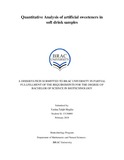| dc.description.abstract | Carbonated drinks are the biggest soft drinks sector around the globe and have grown
significantly over the last few decades. It has become part of the urban lifestyle and is consumed
by people regardless of age, religion, gender, race or culture. With this increasing popularity
came the use of synthetic sweeteners, also known as Non-nutritive sweeteners (NAS), which are
low caloric substances used to replace sugar or corn syrup and other caloric ones. Higher
concentration of some of these sweeteners leads to various side-effects such as physical
weakness, poor night vision, insomnia, mental depression, anxiety, feeling aggressive, weight
gain and so on. Hence, the detection of these sweeteners is important to ensure consistency in
product quality. In this study, a simple, selective, precise and low-cost procedure using the
spectrophotometric method was performed to determine the concentration of three artificial
(aspartame, saccharin, cyclamate) and one natural sweetener (sucrose) in eight brands of
regularly consumed soft drinks. For this purpose, 12 samples from each brand were analyzed,
collected from different supermarkets in Dhaka. Artificial sweeteners were found in all analyzed
products. Mean concentration of aspartame, saccharine, cyclamate and sucrose were found to lie
in the range between 11-104, 1-9, 45-165 and 1800-2000 μg/ml, respectively.
The correlation coefficient of the calibration curve was better than 0.99 (n> 6). The method can
be validated with respect to sensitivity, linearity range, reproducibility, repeatability, recovery,
and robustness, except for saccharine which showed higher %RSD. | en_US |

